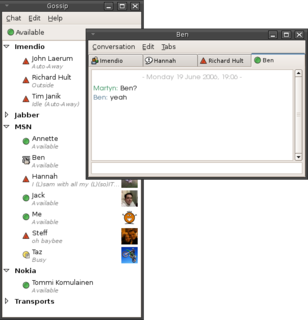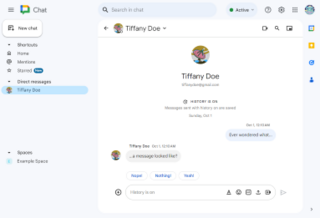History
The term in this context originated with the Toronto and Los Angeles-based company View2Gether [4] which has created proprietary technology for aggregating content from sources not controlled by the user for synchronized play and inclusion in common playlists by multiple participants with a commensurate instant messaging chat function. Other sites which provide similar functionality include Oortle (Photophlow), [5] SeeToo [6] and development of social viewing for existing portals such as Yahoo have recently been announced. [7]
The term has been used in some cases to describe online viewing within the framework of a social network, [8] however View2gether and similar sites have reconfigured the term to mean a common viewing experience as a social activity.
Social viewing has also been used in the past to describe activities such as gathering for the viewing of particular television programs, such as soap operas. [9]
Some examples of modern social viewing sites include Twitch, YouTube, Facebook, TikTok, Instagram, Zoom, and Twitter.
It was also officially added as a built-in feature in some over-the-top media services in various names. While Amazon and Hulu both call it Watch Party, [1] [2] Disney+ (which offers it only in some countries) calls it GroupWatch. [3]
ICQ New is a cross-platform instant messaging (IM) and VoIP client. The name ICQ derives from the English phrase "I Seek You". Originally developed by the Israeli company Mirabilis in 1996, the client was bought by AOL in 1998, and then by Mail.Ru Group in 2010.

The term chat room, or chatroom, is primarily used to describe any form of synchronous conferencing, occasionally even asynchronous conferencing. The term can thus mean any technology ranging from real-time online chat and online interaction with strangers to fully immersive graphical social environments.

Instant messaging (IM) technology is a type of online chat allowing real-time text transmission over the Internet or another computer network. Messages are typically transmitted between two or more parties, when each user inputs text and triggers a transmission to the recipient(s), who are all connected on a common network. It differs from email in that conversations over instant messaging happen in real-time. Most modern IM applications use push technology and also add other features such as emojis, file transfer, chatbots, voice over IP, or video chat capabilities.
Trillian is a proprietary multiprotocol instant messaging application created by Cerulean Studios. It is currently available for Microsoft Windows, Mac OS X, Linux, Android, iOS, BlackBerry OS, and the Web. It can connect to multiple IM services, such as AIM, Bonjour, Facebook Messenger, Google Talk (Hangouts), IRC, XMPP (Jabber), VZ, and Yahoo! Messenger networks; as well as social networking sites, such as Facebook, Foursquare, LinkedIn, and Twitter; and email services, such as POP3 and IMAP.

A webcam is a video camera which is designed to record or stream to a computer or computer network. They are primarily used in videotelephony, livestreaming and social media, and security. Webcams can be built-in computer hardware or peripheral devices, and are commonly connected to a device using USB or wireless protocols.

Yahoo! Messenger was an advertisement-supported instant messaging client and associated protocol provided by Yahoo!. Yahoo! Messenger was provided free of charge and could be downloaded and used with a generic "Yahoo ID" which also allowed access to other Yahoo! services, such as Yahoo! Mail. The service also offered VoIP, file transfers, webcam hosting, a text messaging service, and chat rooms in various categories.
Social software, also known as social apps, include communication and interactive tools often based on the Internet. Communication tools typically handle the capturing, storing and presentation of communication, usually written but increasingly including audio and video as well. Interactive tools handle mediated interactions between a pair or group of users. They focus on establishing and maintaining a connection among users, facilitating the mechanics of conversation and talk. Social software generally refers to software that makes collaborative behaviour, the organisation and moulding of communities, self-expression, social interaction and feedback possible for individuals. Another element of the existing definition of social software is that it allows for the structured mediation of opinion between people, in a centralized or self-regulating manner. The most improved area for social software is that Web 2.0 applications can all promote cooperation between people and the creation of online communities more than ever before. The opportunities offered by social software are instant connection and the opportunity to learn.An additional defining feature of social software is that apart from interaction and collaboration, it aggregates the collective behaviour of its users, allowing not only crowds to learn from an individual but individuals to learn from the crowds as well. Hence, the interactions enabled by social software can be one-on-one, one-to-many, or many-to-many.
Tencent QQ, also known as QQ, is an instant messaging software service and web portal developed by the Chinese tech giant Tencent. QQ offers services that provide online social games, music, shopping, microblogging, movies, and group and voice chat software. As of March 2022, there were 563.8 million monthly active QQ accounts.

Habbo is an online community aimed at teens and young adults. It is owned and operated by Sulake, a Finnish company. Founded in 2000, Habbo has expanded to nine online communities, with users from more than 150 countries. Since August 2012, more than 273 million avatars have been registered with an average of 5 million unique visitors per month.
A virtual world is a computer-simulated environment which may be populated by many users who can create a personal avatar, and simultaneously and independently explore the virtual world, participate in its activities and communicate with others. These avatars can be textual, graphical representations, or live video avatars with auditory and touch sensations. Virtual worlds are closely related to mirror worlds.

In computing, an avatar is a graphical representation of a user or the user's character or persona. Avatars can be two-dimensional icons in Internet forums and other online communities, where they are also known as profile pictures, userpics, or formerly picons. Alternatively, an avatar can take the form of a three-dimensional model, as used in online worlds and video games.

Xfire was a proprietary freeware instant messaging service for gamers that also served as a game server browser with various other features. It was available for Microsoft Windows.

Camfrog is a video chat and instant messaging client that was created by Camshare in October 2003. It allows people to meet others worldwide in video chat and find partners in chat rooms. Camfrog users with broadband internet connections can host and moderate their own video chat rooms. The Camfrog Server software allows users to host video chat rooms based on user interests. In 2008, Camfrog introduced Virtual Gifts. On October 19, 2010, it was announced that Paltalk acquired Camfrog. In 2015, Camfrog announced the introduction of a new software, called Ribbit, which allows people to meet others by swiping through live videos.
An over-the-top (OTT) media service is a media service offered directly to viewers via the Internet. OTT bypasses cable, broadcast, and satellite television platforms; the types of companies that traditionally act as controllers or distributors of such content. It has also been used to describe no-carrier cellphones, with which all communications are charged as data, avoiding monopolistic competition, or apps for phones that transmit data in this manner, including both those that replace other call methods and those that update software.

A second screen involves the use of a computing device to provide an enhanced viewing experience for content on another device, such as a television. In particular, the term commonly refers to the use of such devices to provide interactive features during a broadcast, such as a television program, especially social media posts on social media platforms, like Facebook and Twitter. This type of technology is designed to keep the audience engaged in whatever they are involved in. The use of a second screen has been found to support social television and generate an online conversation around the specific content.
The Nintendo Network is Nintendo's online service which provides online functionality for the Nintendo 3DS and Wii U systems and their compatible games. Announced on January 26, 2012 at an investors' conference, it is Nintendo's second online service after Nintendo Wi-Fi Connection. Former president of Nintendo Satoru Iwata said, "Unlike Nintendo Wi-Fi Connection, which has been focused upon specific functionalities and concepts, we are aiming to establish a platform where various services available through the network for our consumers shall be connected via Nintendo Network service so that the company can make comprehensive proposals to consumers."

Google Chat is a communication service developed by Google. Initially designed for teams and business environments, it has since been made available for general consumers. It provides direct message, group conversations, and spaces, which allow users to create and assign tasks and share files in a central place in addition to chatting. It can be accessed through its own website and app or through the Gmail website and app.
Comparison of user features of messaging platforms refers to a comparison of all the various user features of various electronic instant messaging platforms. This includes a wide variety of resources; it includes standalone apps, platforms within websites, computer software, and various internal functions available on specific devices, such as iMessage for iPhones.
Danmaku, literally translated as “bullet curtain” or “curtain fire”, is a Japanese term for the subtitle system used by online video platforms that allows user to post moving comments onto a video as it is playing. These comments are synchronized to the video timeline, and are typically presented as “shooting” across the screen, resembling a barrage.









